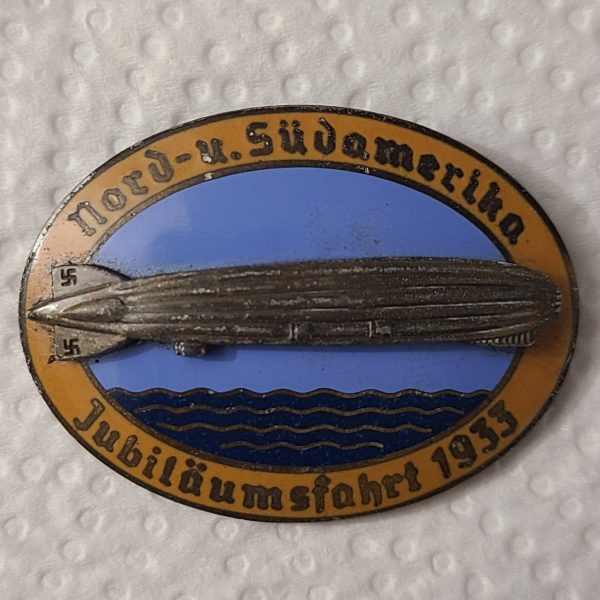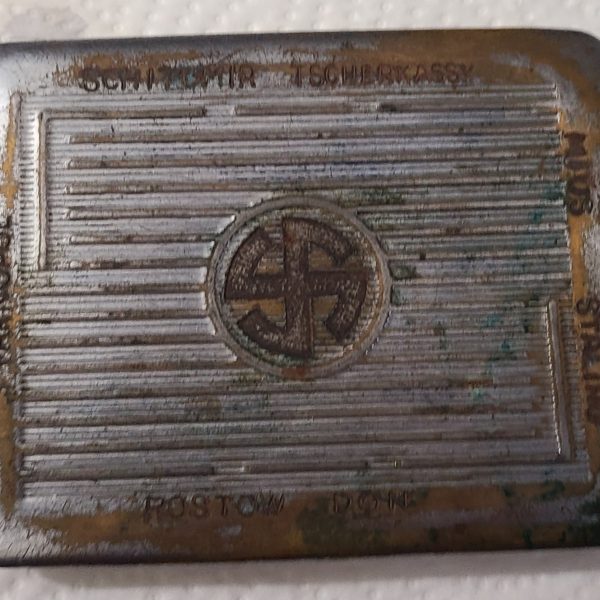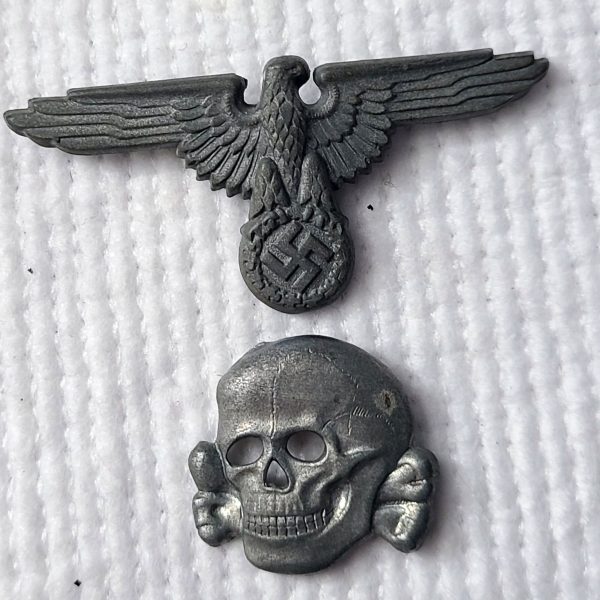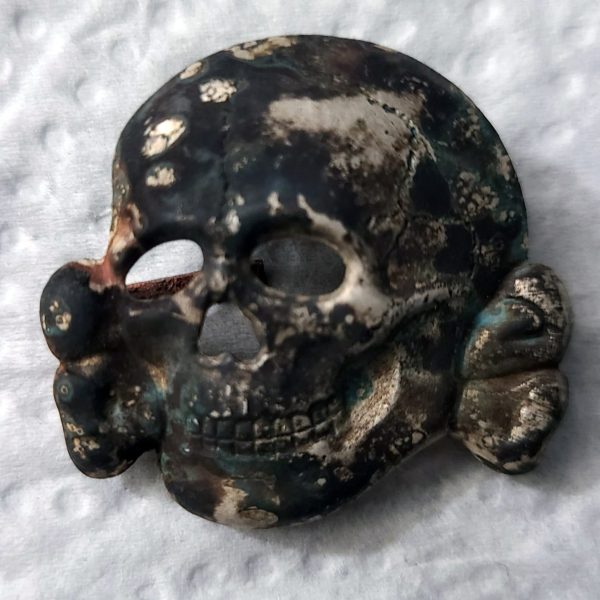$1,150.00
As every collector already knows, there is a lot of controversy about this 800-marked eagle, I had this eagle XRF analyzed and the materials came back 92% silver and 8% copper. Do with that information what you will, Personally, I think that these could have been private purchase options and that the guy in the link below, knows what he’s talking about. This badge is die stamped as you can see the shearing in the side pic.
Here is an example of this eagle for sale from an old collector. SS Eagle M1/17
The two main constituent groups were the Allgemeine SS (General SS) and Waffen-SS (Armed SS). The Allgemeine SS was responsible for enforcing the racial policy of Nazi Germany and general policing, whereas the Waffen-SS consisted of combat units within Nazi Germany’s military. A third component of the SS, the SS-Totenkopfverbände (SS-TV; “Death’s Head Units”), ran the concentration camps and extermination camps. Additional subdivisions of the SS included the Gestapo and the Sicherheitsdienst (SD) organizations. They were tasked with the detection of actual or potential enemies of the Nazi state, the neutralization of any opposition, policing the German people for their commitment to Nazi ideology, and providing domestic and foreign intelligence.
The Waffen-SS was the military branch of the Nazi Party’s SS
The Waffen-SS was the military branch of the Nazi Party’s SS organization. Its formations included men from Nazi Germany, along with volunteers and conscripts from both occupied and unoccupied lands.
The Waffen-SS grew from three regiments to over 38 divisions during World War II and served alongside the Heer (regular army), Ordnungspolizei (uniformed police), and other security units. Originally, it was under the control of the SS Führungshauptamt (SS operational command office) beneath Reichsführer-SS Heinrich Himmler. With the start of World War II, tactical control was exercised by the High Command of the Armed Forces (OKW), with some units being subordinated to Kommandostab Reichsführer-SS (Command Staff Reichsführer-SS) directly under Himmler’s control.
Initially, in keeping with the racial policy of Nazi Germany, membership was open only to people of Germanic origin (so-called Aryan ancestry). The rules were partially relaxed in 1940, and later the formation of units composed largely or solely of foreign volunteers and conscripts was authorized. These SS units were made up of men mainly from among the nationals of Nazi-occupied Europe. Despite the relaxation of the rules, the Waffen-SS was still based on the racist ideology of Nazism, and ethnic Poles were specifically barred from the formations.
The Schutzstaffel (SS; ‘Protection Squadron’) was a major paramilitary organization under Adolf Hitler and the Nazi Party in Nazi Germany, and later throughout German-occupied Europe during World War II. It began with a small guard unit known as the Saal-Schutz (“Hall Security”) made up of party volunteers to provide security for party meetings in Munich. In 1925, Heinrich Himmler joined the unit, which had by then been reformed and given its final name. Under his direction (1929–1945) it grew from a small paramilitary formation during the Weimar Republic to one of the most powerful organizations in Nazi Germany. From the time of the Nazi Party’s rise to power until the regime’s collapse in 1945, the SS was the foremost agency of security, surveillance, and terror within Germany and German-occupied Europe.
The two main constituent groups were the Allgemeine SS (General SS) and Waffen-SS (Armed SS). The Allgemeine SS was responsible for enforcing the racial policy of Nazi Germany and general policing, whereas the Waffen-SS consisted of combat units within Nazi Germany’s military. A third component of the SS, the SS-Totenkopfverbände (SS-TV; “Death’s Head Units”), ran the concentration camps and extermination camps. Additional subdivisions of the SS included the Gestapo and the Sicherheitsdienst (SD) organizations. They were tasked with the detection of actual or potential enemies of the Nazi state, the neutralization of any opposition, policing the German people for their commitment to Nazi ideology, and providing domestic and foreign intelligence.
Waffen-SS Divisions
1st SS divisions1st SS Panzer Division Leibstandarte SS Adolf Hitler2nd SS Panzer Division Das Reich (previously SS Verfügungs Division: later SS Panzergrenadier Division Das Reich)
3rd SS Panzer Division Totenkopf (previously SS Panzergrenadier Division Totenkopf)
4th SS Polizei Division
5th SS Panzer Division Wiking (previously SS Panzergrenadier Division Wiking)
6th SS Mountain Division Nord
7th SS Volunteer Mountain Division Prinz Eugen
8th SS Cavalry Division Florian Geyer
9th SS Panzer Division Hohenstaufen
10th SS Panzer Division Frundsberg
11th SS Volunteer Panzergrenadier Division Nordland
12th SS Panzer Division Hitlerjugend
13th Waffen Mountain Division of the SS Handschar (1st Croatian)
14th Waffen Grenadier Division of the SS (1st Ukrainian) (unofficially known as Galizien)
15th Waffen Grenadier Division of the SS (1st Latvian)
16th SS Panzergrenadier Division Reichsführer-SS
17th SS Panzergrenadier Division Götz von Berlichingen
18th SS Volunteer Panzergrenadier Division Horst Wessel
19th Waffen Grenadier Division of the SS (2nd Latvian)
20th Waffen Grenadier Division of the SS (1st Estonian)
21st Waffen Mountain Division of the SS Skanderbeg (1st Albanian)
22nd SS Volunteer Cavalry Division Maria Theresia (Hungarian)
23rd Waffen Mountain Division of the SS Kama (2nd Croatian)
23rd SS Volunteer Panzergrenadier Division Nederland (1st Dutch), formed after the dissolution of the 23rd Kama division.
24th Waffen Mountain Division of the SS (Karstjäger)
25th Waffen Grenadier Division of the SS Hunyadi (1st Hungarian)
26th Waffen Grenadier Division of the SS Hungaria (2nd Hungarian)
27th SS Volunteer Grenadier Division Langemarck (1st Flemish)
28th SS Volunteer Grenadier Division Wallonien
29th Waffen Grenadier Division of the SS (1st Russian)
29th Waffen Grenadier Division of the SS (1st Italian), formed after the disbanding of the 29th “1st Russian” division.
30th Waffen Grenadier Division of the SS (2nd Russian)
30th Waffen Grenadier Division of the SS (1st Belarusian)
31st SS Volunteer Grenadier Division, variously reported as being named Böhmen-Mähren (Bohemia-Moravia)(this Division is not SS Kampfgruppe Division Bohmen-Mahren, this was a separate unit formed from training units in the protectorate after the Batschka Division) or Batschka.
32nd SS Volunteer Grenadier Division 30 Januar
33rd Waffen Cavalry Division of the SS (3rd Hungarian)
33rd Waffen Grenadier Division of the SS Charlemagne (1st French), the last Waffen-SS unit during the Battle of Berlin to participate in the defense of central Berlin and the area of the Führerbunker.
34th SS Volunteer Grenadier Division Landstorm Nederland
35th SS and Police Grenadier Division
36th Waffen Grenadier Division of the SS Dirlewanger – historically recognized as the most notoriously criminal unit of the Waffen-SS
37th SS Volunteer Cavalry Division Lützow
38th SS Grenadier Division Nibelungen
Also:
SS-Oberabschnitt Böhmen-Mähren
Panzer Division Kempf, a temporary unit of mixed army and Waffen-SS components.
1st Cossack Division
26th SS Panzer Division (Brigade size only, Division title used as a deception)
27th SS Panzer Division (Brigade size only, Division title used as a deception)
1st SS Bartenura Division (Brigade size only, Division title used as a deception)

-

-

-

-
World War 2 was one of the most significant conflicts in modern history. Millions of soldiers and civilians died in the fierce battles between the Allies and the Axis.
Tales of courage and sacrifices still live in the military artifacts that remain in our grandparents’ attics, basements, and footlockers. Iron Cross HQ is very proud to offer a wide selection of WWII uniforms, WWII field gear, weapons, medals, decorations, photos, and more, for sale at Iron Cross HQ Store. Reproduction items and originals are available for Militaria collectors and reenactors.
Iron Cross HQ, as the seller of War memorabilia, would like to emphasize that these items are sold as historical artifacts and collectibles, and not intended to promote or glorify war, violence, or any extremist ideology. We do not condone the actions of any individual or group involved in these conflicts and sell these items solely for their historical significance.